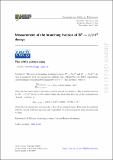Measurement of the branching fraction of B0 → J/ψπ0 decays
Author(s)
Aaij, R.; Abdelmotteleb, A. S. W.; Abellan Beteta, C.; Abudinén, F.; Ackernley, T.; Adams, J. A.; Adefisoye, A. A.; Adeva, B.; Adinolfi, M.; Adlarson, P.; Agapopoulou, C.; Aidala, C. A.; Ajaltouni, Z.; Akar, S.; Akiba, K.; Albicocco, P.; Albrecht, J.; ... Show more Show less
Download13130_2024_Article_23340.pdf (1.034Mb)
Publisher with Creative Commons License
Publisher with Creative Commons License
Creative Commons Attribution
Terms of use
Metadata
Show full item recordAbstract
The ratio of branching fractions between B0 → J/ψπ0 and B+ → J/ψK*+ decays is measured with proton-proton collision data collected by the LHCb experiment, corresponding to an integrated luminosity of 9 fb−1. The measured value is
B
B
0
→
J
/
ψ
π
0
B
B
+
→
J
/
ψ
K
∗
+
=
1.153
±
0.053
±
0.048
×
10
−
2
,
$$ \frac{{\mathcal{B}}_{B^0\to J/\psi {\pi}^0}}{{\mathcal{B}}_{B^{+}\to J/\psi {K}^{\ast +}}}=\left(1.153\pm 0.053\pm 0.048\right)\times {10}^{-2}, $$
where the first uncertainty is statistical and the second is systematic. The branching fraction for B0 → J/ψπ0 decays is determined using the branching fraction of the normalisation channel, resulting in
B
B
0
→
J
/
ψ
π
0
=
1.670
±
0.077
±
0.069
±
0.095
×
10
−
5
,
$$ {\mathcal{B}}_{B^0\to J/\psi {\pi}^0}=\left(1.670\pm 0.077\pm 0.069\pm 0.095\right)\times {10}^{-5}, $$
where the last uncertainty corresponds to that of the external input. This result is consistent with the current world average value and competitive with the most precise single measurement to date.
Date issued
2024-05-07Department
Massachusetts Institute of Technology. Department of PhysicsJournal
Journal of High Energy Physics
Publisher
Springer Science and Business Media LLC
Citation
The LHCb collaboration., Aaij, R., Abdelmotteleb, A.S.W. et al. Measurement of the branching fraction of B0 → J/ψπ0 decays. J. High Energ. Phys. 2024, 65 (2024).
Version: Final published version
ISSN
1029-8479